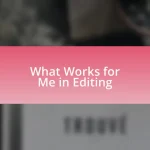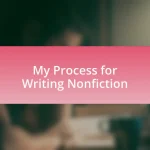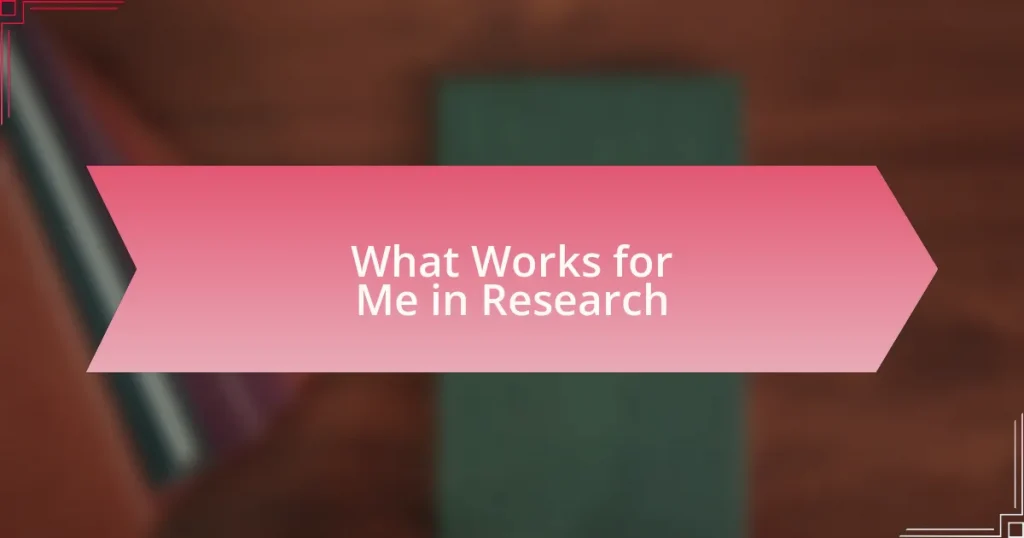Key takeaways:
- Split infinitives occur when an adverb is placed between “to” and a verb, which can enhance clarity and impact in writing.
- The debate around split infinitives reflects tension between traditional grammar rules and modern language usage.
- Common misconceptions include viewing split infinitives as errors and believing they confuse readers; in reality, they can enhance communication.
- Using split infinitives can improve the flow of a sentence and emphasize important ideas, making writing more relatable and effective.
Author: Clara Whitfield
Bio: Clara Whitfield is a captivating storyteller and acclaimed author known for her rich, character-driven narratives that explore the complexities of human relationships. With a background in psychology and a passion for literature, Clara weaves intricate plots that resonate with readers on multiple levels. Her debut novel, “Echoes of the Heart,” received critical acclaim and was a finalist for several literary awards. When she’s not writing, Clara enjoys hiking in nature, experimenting in the kitchen, and engaging with her vibrant community of fellow writers. She resides in Portland, Oregon, where she draws inspiration from the lush surroundings and eclectic culture.
Understanding split infinitives
When I first encountered the concept of split infinitives, I was surprised to find that something so seemingly simple sparked such spirited debate among grammar enthusiasts. A split infinitive occurs when an adverb or other word is inserted between “to” and the verb, as in “to boldly go.” It challenges the conventional idea of keeping “to” and the verb together, but in practice, it can add clarity and impact to a sentence.
One day, while discussing this very topic in a writing workshop, a fellow participant shared how using a split infinitive transformed a mundane sentence into something memorable. It reminded me that language is alive and fluid; sometimes, breaking the so-called rules can breathe life into our writing. Isn’t it interesting how innovation, even in grammar, can provoke both excitement and hesitation?
As I reflect on my own writing experiences, I’ve found that split infinitives often help me convey my thoughts with greater precision. For instance, saying “to really understand” conveys depth of understanding better than just “to understand.” This small adjustment can significantly change how the reader perceives the intended meaning. Isn’t that what language is all about—communication and connection?
The history of split infinitives
The history of split infinitives is quite fascinating and reflects the evolving nature of English grammar. The term gained prominence in the 19th century when prescriptive grammarians, who sought to enforce rules akin to those of Latin, criticized the structure. I remember reading about a famous example: Star Trek’s iconic “to boldly go,” which not only became a cultural touchstone but also sparked further debate on whether strict adherence to grammar rules stifles creativity.
Interestingly, despite the backlash, split infinitives have persisted in everyday language. When I first learned about their contentious nature in school, I was perplexed—why should such a small change cause such a stir? My experience shows that many writers, including myself, often prioritize clarity and rhythm over rigid rules, suggesting that the rules may need to adapt to our expressive needs.
In the early 20th century, the tide began to turn as more writers and linguists embraced the split infinitive as a legitimate construction. Reflecting on my own writing journey, I’ve often prefixed verbs with adverbs in a way that felt more natural and impactful. It makes me wonder: could our insistence on “proper” grammar actually limit our ability to communicate effectively? Ultimately, the debate around split infinitives reveals the tension between tradition and innovation in language, prompting us to reconsider what truly constitutes effective writing.
When to use split infinitives
When writing, I often find that split infinitives come into play when I want to emphasize an adverb. For example, in a sentence like “She decided to really focus on her studies,” the placement of “really” right before “focus” adds clarity and emphasis that feels natural. It strikes me that sometimes, using a split infinitive just makes the sentence flow better, almost like how we naturally speak.
There are moments when I’ve hesitated to use a split infinitive, worrying about how it might be perceived. Yet, I’ve gradually learned that the effectiveness of the message is what matters most. When I stressed “to boldly go” in my own writing, it didn’t just sound appealing—it captured the spirit of adventure that I wanted to convey. Have you ever found yourself weighing grammatical rules against how you truly want to express an idea?
In informal writing, I believe split infinitives can enhance readability and prevent awkward phrasing. I distinctly remember a time when I revised a piece to say “to completely understand” instead of “to understand completely.” The change felt right, and the sentence conveyed my intent more powerfully. This experience taught me that the choice to split an infinitive isn’t merely about following strict rules; it’s about enhancing communication and making my point resonate with the reader.
Common misconceptions about split infinitives
Many people mistakenly believe that split infinitives are a grammatical error to avoid at all costs. I used to subscribe to this notion, feeling uncomfortable about splitting infinitives in my writing. However, I’ve come to realize that this viewpoint often overlooks the fluidity and natural rhythm of modern English. Who gets to decide what is “incorrect” when language is always evolving?
Another common misconception is that split infinitives confuse readers. In my experience, clarity in writing often depends on the overall structure of the sentence rather than the position of the infinitive. I remember working on a report filled with technical jargon, and I felt compelled to say “to thoroughly explain” rather than “to explain thoroughly.” The split infinitive brought an engaging clarity to my point, allowing me to communicate effectively without losing my audience’s attention.
Some might argue that they sound awkward or overly casual. Yet, I recall experimenting with different sentence structures during my creative writing classes. I found that instances like “to care deeply” conveyed emotions more powerfully than the alternatives. It’s curious to think how a small change in placement can transform a sentence’s impact—why should we shy away from experimenting with these forms?















